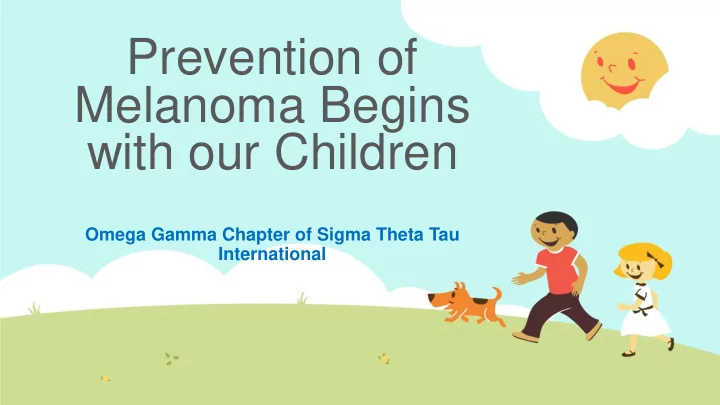

Prevention of Melanoma Begins with our Children Omega Gamma Chapter of Sigma Theta Tau International
Why Sun Safety Education? Overexposure to ultraviolet (UV) radiation is the primary environmental risk factor in the development of UV-related health effects. 1:5 Americans develop skin cancer Sun safety education is a vital step toward reducing risk and improving public health. Unprotected sun exposure in youths increases lifetime risk for skin cancer. Other adverse health effects resulting from overexposure to UV radiation include: eye damage and cataracts immune system suppression premature aging of the skin. (https://www.epa.gov/sites/production/files/documents/actionsteps.pdf)
Sun Safety Education Overexposure to the sun is an important health issue for all skin types. Myth: Only lighter-skinned people need to be concerned about overexposure Fact: Though it is true that darker skin has more natural pigment, which acts as a protectant, darker skin is still susceptible to many of the damaging effects of UV radiation Fact: The risk of other UV-related health effects is not dependent upon skin type. Good news! UV-related health effects are largely preventable by instituting sun-protection practices early and consistently. Schools, teachers and nurses can play a major role in protecting children by teaching and role-modeling sun safety behaviors. (https://www.epa.gov/sites/production/files/documents/introduction.pdf)
SunWise Action Steps for Sun Protection Apply broad-spectrum, SPF 30 or higher sunscreen to all exposed skin, reapplying every two hours and after swimming or sweating; Wear protective clothing , such as long-sleeve shirts and pants; Set sun-safe fashion trends by wearing a hat ; Rock a pair of sunglasses for eye protection; Seek shade when needed: the sun’s UV rays are strongest between 10AM and 4PM; Check the UV Index (link is on next slide) before planning outdoor activities; Avoid sun tanning and tanning beds; and Get vitamin D safely, through vitamin supplements and fortified foods. (https://www.neefusa.org/action-steps-sun-protection)
Special Considerations for Children Recent medical research shows that it is important to protect children and young adults from overexposure to UV radiation. For babies under 6 months, the American Academy of Pediatrics recommends (1) avoiding sun exposure, and (2) dressing infants in lightweight long pants, long-sleeved shirts, and brimmed hats. Parents can also apply sunscreen (SPF 15+) to small areas like the face and back of the hands if protective clothing and shade are not available. EPA’s SunWise Program In response to the serious public health threat posed by overexposure to UV radiation, EPA is working with schools and communities across the nation through the SunWise Program. (https://www.epa.gov/sites/production/files/documents/actionsteps.pdff)
ABCDE RULE to look for signs of Melanoma Use the “ABCDE rule” to look for some of the common signs of melanoma, one of the deadliest forms of skin cancer: Asymmetry One part of a mole or birthmark doesn’t match the other. Border The edges are irregular, ragged, notched, or blurred. Color The color is not the same all over and may include shades of brown or black, sometimes with patches of pink, red, white, or blue. Diameter The spot is larger than ¼ inch across – about the size of a pencil eraser – although melanomas can sometimes be smaller than this. Evolving The mole is changing in size, shape, or color. (https://www.cancer.org/latest-news/how-to-spot-skin-cancer.html)
Frequently asked questions about sun safety Is the level of UV protection in moisturizer & cosmetics that have an SPF as effective as the sun protection afforded by sunscreen? What SPF level is recommended by health organizations? Is it possible to get a sunburn if it’s cloudy? Should I wait before getting in the water after applying sunscreen? Does Sunscreen expire? Will a “base tan” offer protection from further skin damage from the sun? Should people of color be concerned about sun safety? What are some major body parts that are often missed by sunscreen? What should be done if I’m worried I have skin damage from the sun? For answers go to: https://www.neefusa.org/weather-and-climate/weather/uv-safety#Moisturizer
Sun Safety Resources Register to receive the free SunWise Tool Kit: http://go.neefusa.org/sunwise • Check the outdoor air quality with AirNow: https://www.airnow.gov/ • View the EPA’s UV Index: https://www.epa.gov/sunsafety/uv-index-1 Learn about how animals protect themselves from the sun’s rays: https://www.neefusa.org/resource/who-am-i-sunwise-animals Learn more about UV radiation: https://www.neefusa.org/learn-more-about-uv- radiation Check out this helpful infographic from the American Cancer Society: https://www.cancer.org/research/infographics-gallery/skin-cancer- prevention.html
If you would like to provide a sun protection workshop in your community Tools for SunWise Living Environmental Protection Agency’s (EPA) SunWise Program can tailor an agenda to meet the needs of your workshop, from a 30- minute overview presentation to a day-long training session. Please contact the EPA at sunwise@epa.gov for additional information on how to organize a SunWise workshop. (https://www.epa.gov/sites/production/files/documents/introduction.pdff)
Apply for a Research Grant If you are a graduate nursing student and interested in applying, check out this link: https://www.cancer.org/research/we-fund-cancer-research/apply-research- grant.html
References How to spot skin cancer https://www.cancer.org/latest-news/how-to-spot-skin- cancer.html EPA. 2018. Don’t Fry Day. Environmental Protection Agency. Accessed May 22. https://www.epa.gov/sunsafety/dont-fry-day Don’t Fry Day. 2018. National Council on Skin Cancer Prevention. Accessed May 22. https://www.skincancerprevention.org/programs/dont-fry-day NEEF. 2018. NEEF SunWise. National Environmental Education Foundation. https://www.neefusa.org/sunwise NEEF. 2018. Learn More About UV Radiation. National Environmental Education Foundation. https://www.neefusa.org/learn-more-about-uv-radiation#UV%20Index NEEF. 2018. Action Steps for Sun Protection. National Environmental Education Foundation. https://www.neefusa.org/action-steps-sun-protection
Recommend
More recommend